2017 NISSAN LEAF harness
[x] Cancel search: harnessPage 11 of 48
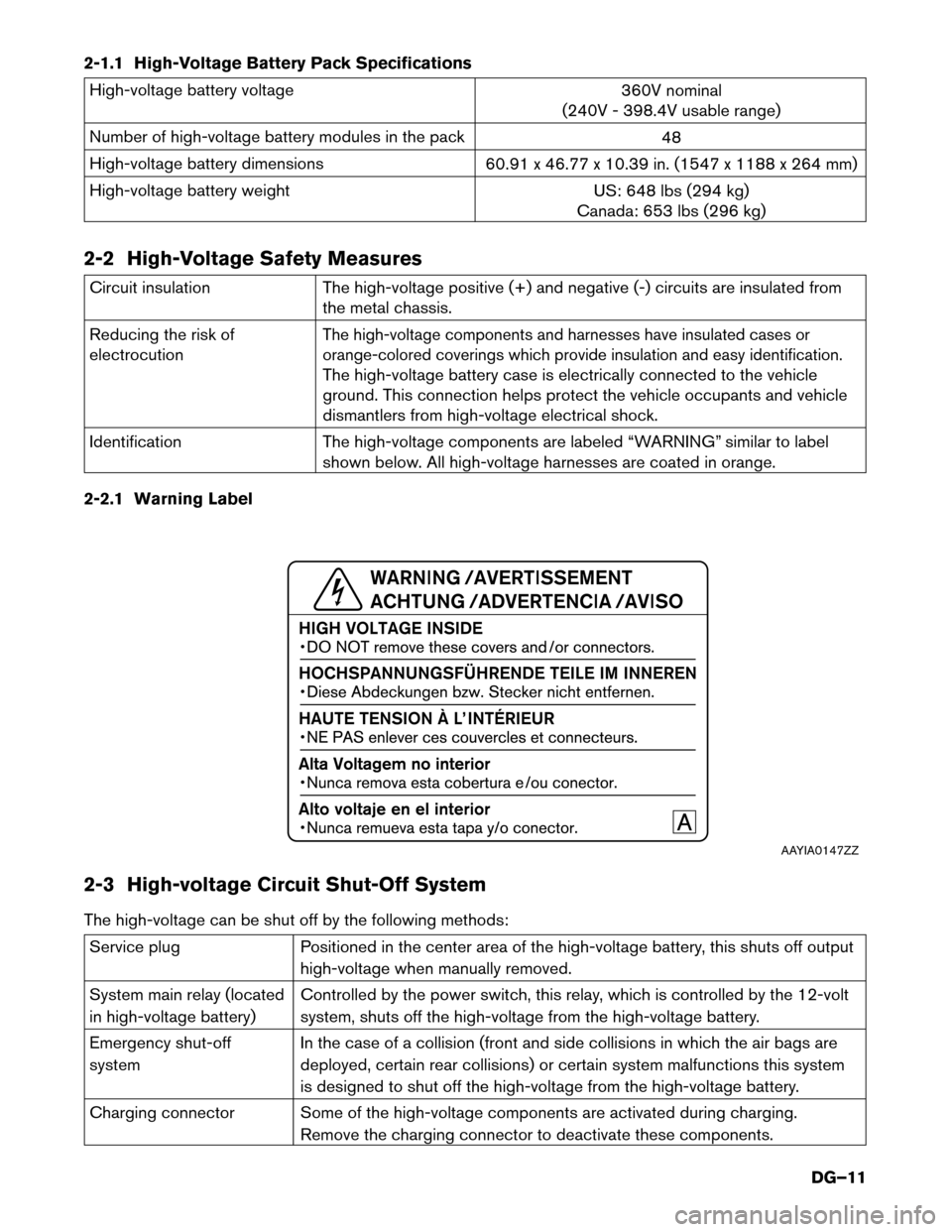
2-1.1 High-Voltage Battery Pack Specifications
High-voltage battery voltage
360V nominal
(240V - 398.4V usable range)
Number of high-voltage battery modules in the pack 48
High-voltage battery dimensions 60.91 x 46.77 x 10.39 in. (1547 x 1188 x 264 mm)
High-voltage battery weight US: 648 lbs (294 kg)
Canada: 653 lbs (296 kg)
2-2 High-Voltage Safety Measures Circuit insulation
The high-voltage positive (+) and negative (-) circuits are insulated from
the
metal chassis.
Reducing the risk of
electrocution
The high-voltage components and harnesses have insulated cases or
orange-colored coverings which provide insulation and easy identification.
The high-voltage battery case is electrically connected to the vehicle
ground. This connection helps protect the vehicle occupants and vehicle
dismantlers from high-voltage electrical shock.
Identification The high-voltage components are labeled “WARNING” similar to label shown below. All high-voltage harnesses are coated in orange.
2-2.1 Warning Label
2-3 High-voltage Circuit Shut-Off System
The high-voltage can be shut off by the following methods: Service plug
Positioned in the center area of the high-voltage battery, this shuts off output
high-voltage
when manually removed.
System main relay (located
in high-voltage battery) Controlled by the power switch, this relay, which is controlled by the 12-volt
system, shuts off the high-voltage from the high-voltage battery.
Emergency shut-off
system In the case of a collision (front and side collisions in which the air bags are
deployed, certain rear collisions) or certain system malfunctions this system
is designed to shut off the high-voltage from the high-voltage battery.
Charging connector Some of the high-voltage components are activated during charging. Remove the charging connector to deactivate these components. AAYIA0147ZZ
DG–11
Page 12 of 48

2-4 Preventing Electrical Shock
1. If it is necessary to touch any of the high-voltage harnesses or components, you must always
wear appropriate Personal Protective Equipment (PPE)
(refer to 3-2 Preparation Items (DG–15) ) and shut off the high-voltage system by referring to
3-4 High-voltage System Shut-Down Procedures (DG–16).
2.
To avoid the risk of electrocution, NEVER touch the inside of the high-voltage battery unless
appropriate PPE is worn even after shutting off the high-voltage system. The high-voltage battery
maintains charge even though the high-voltage system is shut down.
3. Cover any damaged high-voltage components with insulated tape.
DG–12
Page 13 of 48
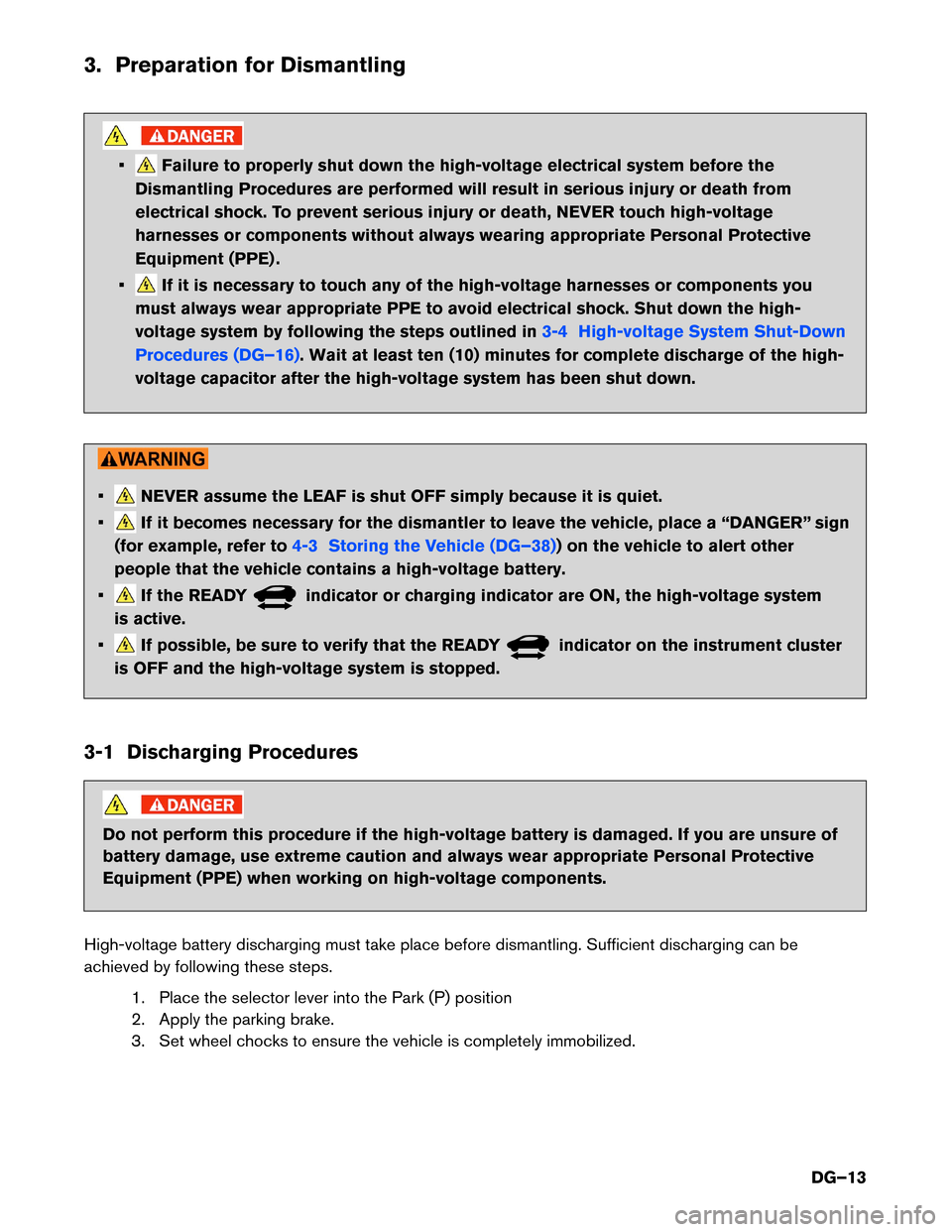
3. Preparation for Dismantling
• Failure to properly shut down the high-voltage electrical system before the
Dismantling Procedures are performed will result in serious injury or death from
electrical shock. To prevent serious injury or death, NEVER touch high-voltage
harnesses or components without always wearing appropriate Personal Protective
Equipment (PPE) .
• If it is necessary to touch any of the high-voltage harnesses or components you
must
always wear appropriate PPE to avoid electrical shock. Shut down the high-
voltage system by following the steps outlined in 3-4 High-voltage System Shut-Down
Procedures
(DG–16) . Wait at least ten (10) minutes for complete discharge of the high-
voltage
capacitor after the high-voltage system has been shut down. • NEVER assume the LEAF is shut OFF simply because it is quiet.
• If it becomes necessary for the dismantler to leave the vehicle, place a “DANGER” sign
(for
example, refer to 4-3 Storing the Vehicle (DG–38)) on the vehicle to alert other
people
that the vehicle contains a high-voltage battery.
• If the READY indicator or charging indicator are ON, the high-voltage system
is
active.
• If possible, be sure to verify that the READY indicator on the instrument cluster
is
OFF and the high-voltage system is stopped.
3-1 Discharging Procedures Do not perform this procedure if the high-voltage battery is damaged. If you are unsure of
battery
damage, use extreme caution and always wear appropriate Personal Protective
Equipment (PPE) when working on high-voltage components.
High-voltage battery discharging must take place before dismantling. Sufficient discharging can be
achieved by following these steps. 1. Place the selector lever into the Park (P) position
2. Apply the parking brake.
3. Set wheel chocks to ensure the vehicle is completely immobilized.
DG–13
Page 15 of 48

3-2 Preparation Items
Preparation Items
Specification Purpose
Personal Protective
Equipment (PPE):
Insulated gloves Up to 1,000V
For protection from high-voltage
electrical
shock
Insulated shoes –
Safety
shield –
Leather
gloves Must be able to fasten tight
around
the wrist (worn over
insulated gloves) . To protect insulated gloves
Wrenches Size:10mm
T
o remove the service plug access
cover bolts.
To remove the 12-volt battery terminal
bolt.
Solvent resistant protection
gloves –
To utilize in the event of a high-
voltage battery electrolytic solution
leak.
Solvent resistant protection
shoes –
Absorbent pad The same pad used for internal
combustion engine fluids can be
used. To absorb any high-voltage battery
electrolytic solution leakage.
Standard fire fighting
equipment Standard fire fighting equipment
Depending on type of fire (vehicle
or battery) use standard fire
fighting equipment (water or
extinguisher) . To extinguish a fire.
Insulated tape Insulating
To cover any damaged harnesses to
protect from and prevent electrical
shock. Tape should cover all bare or
damaged wire.
DG–15
Page 16 of 48
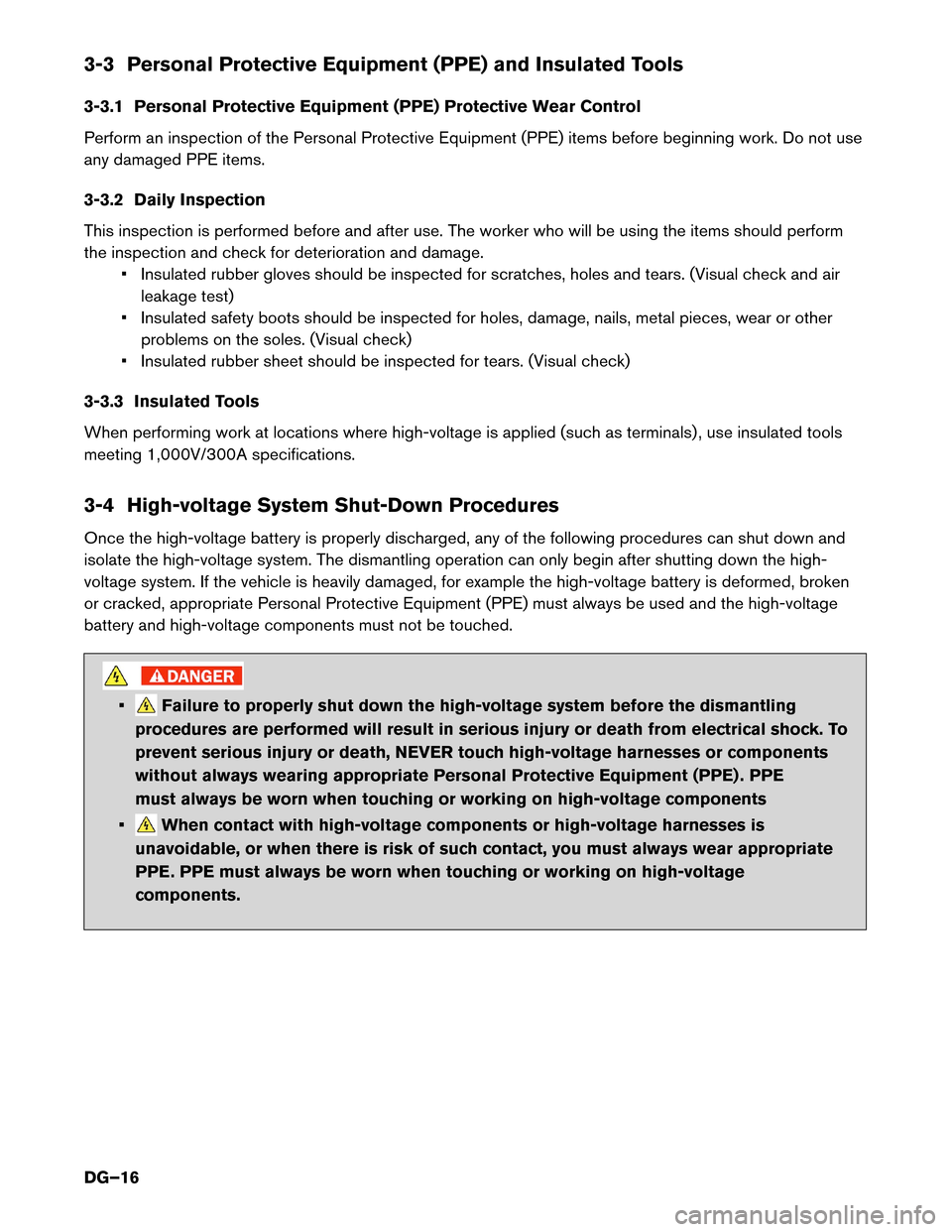
3-3 Personal Protective Equipment (PPE) and Insulated Tools
3-3.1
Personal Protective Equipment (PPE) Protective Wear Control
Perform an inspection of the Personal Protective Equipment (PPE) items before beginning work. Do not use
any damaged PPE items.
3-3.2 Daily Inspection
This inspection is performed before and after use. The worker who will be using the items should perform
the inspection and check for deterioration and damage. • Insulated rubber gloves should be inspected for scratches, holes and tears. (Visual check and airleakage test)
• Insulated safety boots should be inspected for holes, damage, nails, metal pieces, wear or other problems on the soles. (Visual check)
• Insulated rubber sheet should be inspected for tears. (Visual check)
3-3.3 Insulated Tools
When performing work at locations where high-voltage is applied (such as terminals) , use insulated tools
meeting 1,000V/300A specifications.
3-4 High-voltage System Shut-Down Procedures
Once the high-voltage battery is properly discharged, any of the following procedures can shut down and
isolate the high-voltage system. The dismantling operation can only begin after shutting down the high-
voltage system. If the vehicle is heavily damaged, for example the high-voltage battery is deformed, broken
or cracked, appropriate Personal Protective Equipment (PPE) must always be used and the high-voltage
battery and high-voltage components must not be touched. • Failure to properly shut down the high-voltage system before the dismantling
procedures
are performed will result in serious injury or death from electrical shock. To
prevent serious injury or death, NEVER touch high-voltage harnesses or components
without always wearing appropriate Personal Protective Equipment (PPE) . PPE
must always be worn when touching or working on high-voltage components
• When contact with high-voltage components or high-voltage harnesses is
unavoidable,
or when there is risk of such contact, you must always wear appropriate
PPE. PPE must always be worn when touching or working on high-voltage
components.
DG–16
Page 17 of 48
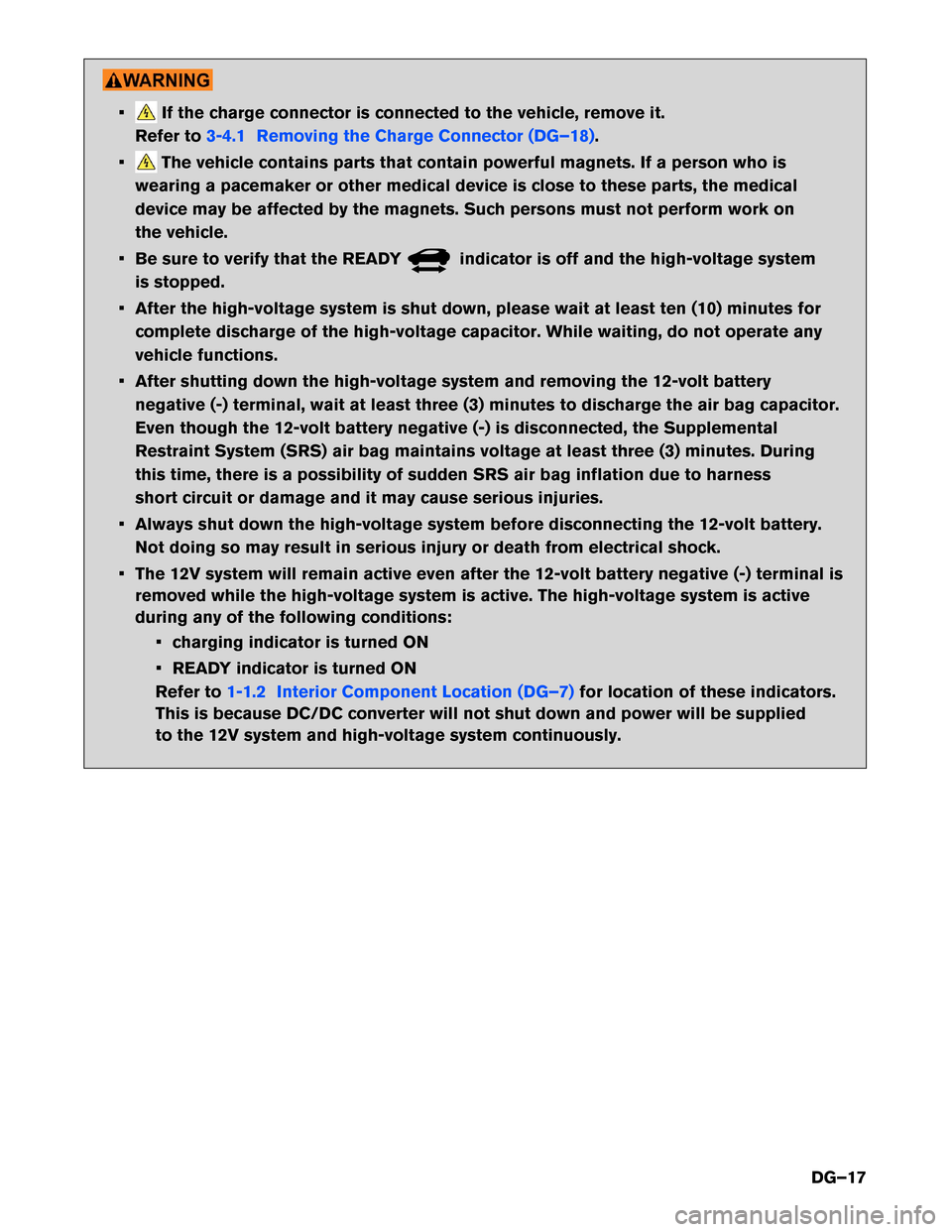
• If the charge connector is connected to the vehicle, remove it.
Refer to3-4.1 Removing the Charge Connector (DG–18).
• The vehicle contains parts that contain powerful magnets. If a person who is
wearing
a pacemaker or other medical device is close to these parts, the medical
device may be affected by the magnets. Such persons must not perform work on
the vehicle.
• Be sure to verify that the READY indicator is off and the high-voltage system
is
stopped.
• After the high-voltage system is shut down, please wait at least ten (10) minutes for complete discharge of the high-voltage capacitor. While waiting, do not operate any
vehicle functions.
• After shutting down the high-voltage system and removing the 12-volt battery negative (-) terminal, wait at least three (3) minutes to discharge the air bag capacitor.
Even though the 12-volt battery negative (-) is disconnected, the Supplemental
Restraint System (SRS) air bag maintains voltage at least three (3) minutes. During
this time, there is a possibility of sudden SRS air bag inflation due to harness
short circuit or damage and it may cause serious injuries.
• Always shut down the high-voltage system before disconnecting the 12-volt battery. Not doing so may result in serious injury or death from electrical shock.
• The 12V system will remain active even after the 12-volt battery negative (-) terminal is removed while the high-voltage system is active. The high-voltage system is active
during any of the following conditions:
• charging indicator is turned ON
• READY indicator is turned ON
Refer to 1-1.2 Interior Component Location (DG–7) for location of these indicators.
This
is because DC/DC converter will not shut down and power will be supplied
to the 12V system and high-voltage system continuously.
DG–17
Page 31 of 48
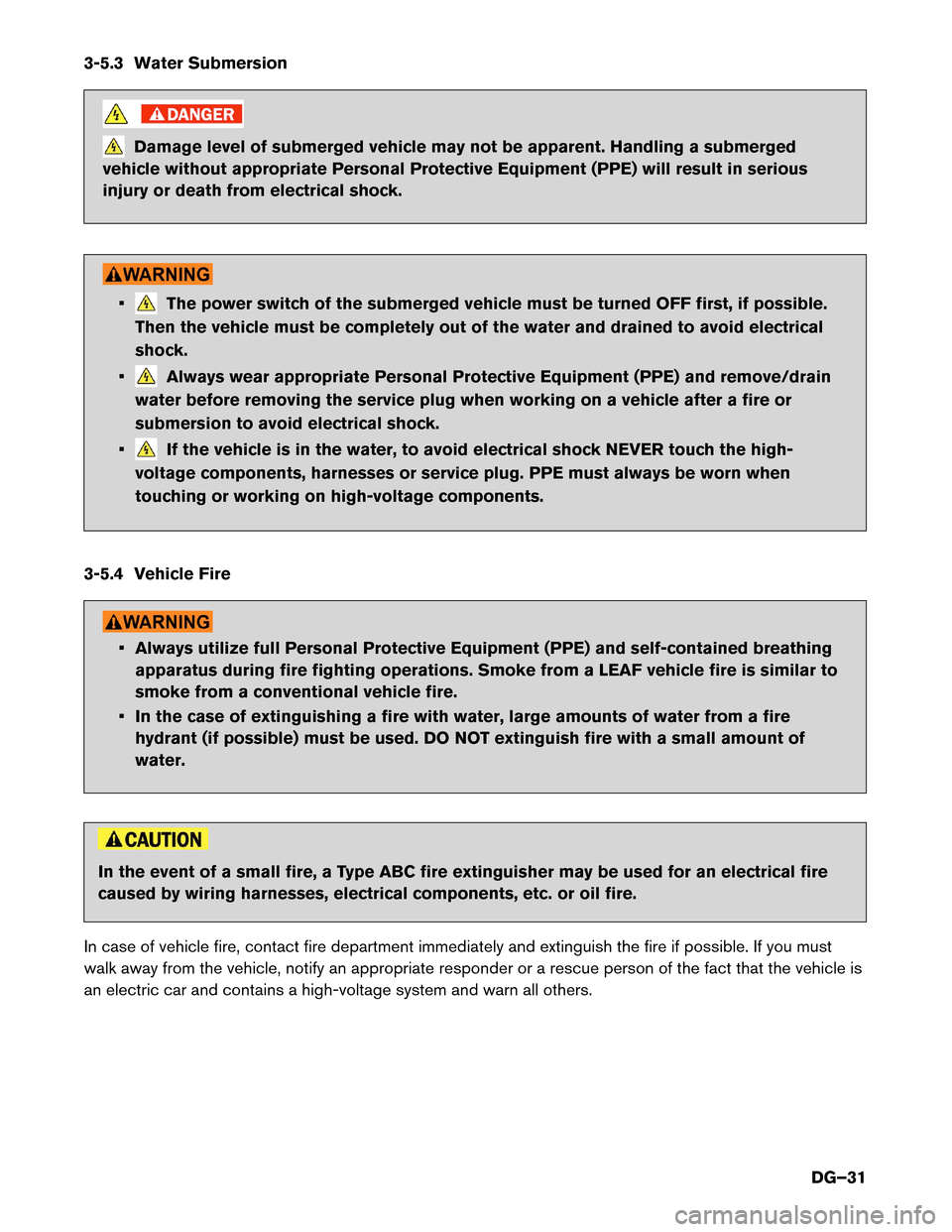
3-5.3 Water Submersion
Damage level of submerged vehicle may not be apparent. Handling a submerged
vehicle without appropriate Personal Protective Equipment (PPE) will result in serious
injury or death from electrical shock. • The power switch of the submerged vehicle must be turned OFF first, if possible.
Then
the vehicle must be completely out of the water and drained to avoid electrical
shock.
• Always wear appropriate Personal Protective Equipment (PPE) and remove/drain
water
before removing the service plug when working on a vehicle after a fire or
submersion to avoid electrical shock.
• If the vehicle is in the water, to avoid electrical shock NEVER touch the high-
voltage
components, harnesses or service plug. PPE must always be worn when
touching or working on high-voltage components.
3-5.4 Vehicle Fire • Always utilize full Personal Protective Equipment (PPE) and self-contained breathing
apparatus
during fire fighting operations. Smoke from a LEAF vehicle fire is similar to
smoke from a conventional vehicle fire.
• In the case of extinguishing a fire with water, large amounts of water from a fire hydrant (if possible) must be used. DO NOT extinguish fire with a small amount of
water. In the event of a small fire, a Type ABC fire extinguisher may be used for an electrical fire
caused
by wiring harnesses, electrical components, etc. or oil fire.
In case of vehicle fire, contact fire department immediately and extinguish the fire if possible. If you must
walk away from the vehicle, notify an appropriate responder or a rescue person of the fact that the vehicle is
an electric car and contains a high-voltage system and warn all others.
DG–31
Page 40 of 48

5. Dismantling Information
Removal
or repair of the high-voltage battery requires special tools and specific training. Nissan strongly
recommends that only NISSAN certified LEAF dealer technicians perform these operations.
5-1 Precautions for Handling High-voltage Battery • Because LEAF contains a high-voltage battery, there is the risk of electric shock,
electric
leakage, or similar accidents if the high-voltage components or vehicle is
handled incorrectly. Be sure to follow the correct work procedures when performing
inspection and dismantling.
• If it is necessary to touch any of the high-voltage harnesses or components you
must
always wear appropriate Personal Protective Equipment (PPE) and properly
shut-down the high-voltage system by removing the service plug.
• Be sure to always wear appropriate PPE before beginning work on the high-voltage
system.
• Be sure to remove the service plug in order to shut-down the high-voltage system
before
performing inspection or dismantling of high-voltage system harnesses and
parts.
• If the vehicle is heavily damaged, for example the high-voltage battery is deformed,
broken,
or cracked; appropriate PPE must always be used at all times to avoid
electrical shock.
DG–40